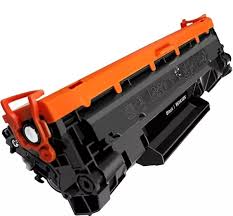This white paper explores the landscape of laser printer toners, focusing on the distinctions between new and recycled cartridges, and the critical role of in-built chip counters in modern printing technology.
Laser Toner: New, Recycled, and the Role of In-Built Chip Counters
Executive Summary
This white paper explores the landscape of laser printer toners, focusing on the distinctions between new and recycled cartridges, and the critical role of in-built chip counters in modern printing technology.
1. Introduction
Laser printers have become ubiquitous in modern offices and homes. A key component of their operation is the toner cartridge, containing the fine powder that fuses to paper to create images. The choice between new (original equipment manufacturer - OEM) and recycled toner cartridges presents a significant decision for consumers and businesses.
2. New (OEM) Toner Cartridges
- Advantages:
- Guaranteed Quality: OEM cartridges are manufactured by the printer manufacturer, ensuring compatibility and optimal performance.
- Reliability: Typically offer consistent print quality, fewer malfunctions, and longer lifespans.
- Customer Support: Backed by the manufacturer's warranty and customer support.
- Disadvantages:
- Higher Cost: Generally more expensive than recycled alternatives.
- Environmental Impact: Production and transportation contribute to a larger carbon footprint.
3. Recycled Toner Cartridges
- Advantages:
- Cost-Effectiveness: Significantly lower cost compared to OEM cartridges.
- Environmental Benefits: Reduce electronic waste and conserve resources.
- Growing Quality: Modern recycling processes have significantly improved the quality of recycled cartridges.
- Disadvantages:
- Potential for Incompatibility: May not always be compatible with specific printer models or offer the same print quality as OEM cartridges.
- Reliability Concerns: Can sometimes experience issues like inconsistent printing, premature failure, or toner leaks.
- Warranty Voidance: Using non-OEM cartridges may void the printer's warranty in some cases.
4. The Role of In-Built Chip Counters
- Functionality: Chip counters are embedded in toner cartridges to track toner levels and communicate with the printer.
- Benefits:
- Accurate Toner Level Monitoring: Provides accurate readings to the printer, allowing for timely replacement and preventing unexpected print interruptions.
- Page Yield Tracking: Helps users estimate printing costs and plan for future toner purchases.
- Printer Maintenance: Assists in printer maintenance by providing valuable data on toner usage and cartridge performance.
- Challenges:
- Compatibility Issues: Recycled cartridges may sometimes have issues with chip recognition, leading to errors or incorrect toner level readings.
- Chip Resetting: Some recycled cartridge manufacturers may need to reset or modify the chip to ensure compatibility with the printer.
5. Choosing the Right Toner:
- Consideration Factors:
- Budget: Recycled cartridges offer significant cost savings.
- Print Volume: High-volume printing may justify the investment in OEM cartridges.
- Print Quality Requirements: Critical applications may necessitate the use of OEM cartridges.
- Environmental Concerns: Recycled cartridges minimize environmental impact.
- Printer Warranty: Check the printer manufacturer's warranty policy regarding the use of non-OEM cartridges.
6. Future Trends:
- Advancements in Recycling Technology: Continued improvements in recycling processes will enhance the quality and reliability of recycled cartridges.
- Smart Cartridge Technology: Integration of advanced sensors and communication technologies will provide real-time data on toner levels, cartridge health, and potential issues.
- Sustainability Initiatives: Increased focus on eco-friendly manufacturing and recycling practices within the printing industry.
7. Conclusion
The choice between new and recycled laser toner cartridges involves a careful consideration of factors such as cost, quality, environmental impact, and printer compatibility. The integration of advanced chip counter technology plays a crucial role in ensuring optimal performance and user experience, regardless of the toner cartridge type.
References
- [1] Environmental Protection Agency (EPA):
- [2] International Organization for Standardization (ISO): (Standards related to environmental management and electronic waste)
- [3] Printer Manufacturer Websites: Refer to the websites of specific printer manufacturers for information on toner compatibility, warranty policies, and recommended usage.
- [4] Industry Publications: Research articles and reports from industry publications specializing in printing technology and office equipment.
Disclaimer: This white paper provides general information and should not be considered professional advice. The specific recommendations and considerations may vary depending on individual needs and circumstances.
Note: This white paper provides a basic framework. For a more in-depth analysis, you would need to conduct further research and consult with experts in the printing and recycling industries. Contact keencomputer.com for details.
